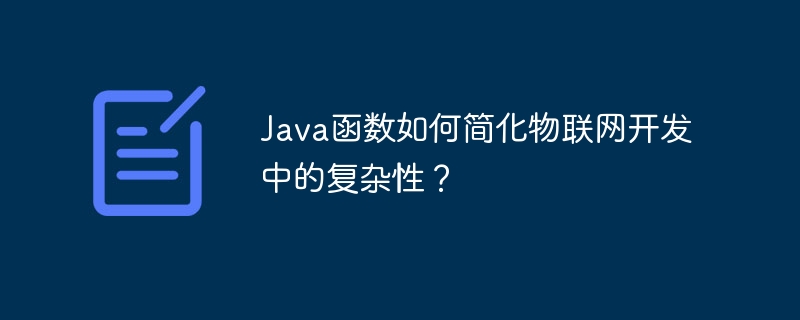Home >Java >javaTutorial >How can Java functions simplify complexity in IoT development?
How can Java functions simplify complexity in IoT development?
- WBOYWBOYWBOYWBOYWBOYWBOYWBOYWBOYWBOYWBOYWBOYWBOYWBOriginal
- 2024-04-28 13:33:02982browse
In IoT development, Java functions simplify massive data processing and provide the following advantages: pay-as-you-go, reducing costs; automatic scaling to ensure availability; event-driven to improve efficiency; and can be integrated with IoT platforms.

Java Functions: A tool that simplifies IoT development
In Internet of Things (IoT) development, handle data from a large number of connected devices The massive amount of data is a daunting task. Java functions significantly simplify this process by providing an efficient and scalable way to process and route this data.
What is a Java function?
Java Functions is a serverless computing platform that allows developers to write and deploy code that runs only when needed. This means you don’t need to provision or manage infrastructure upfront, which saves significant costs and time.
Advantages of Java Functions in IoT Development
- Pay as you go: Pay only when your code runs , thereby reducing development costs.
- Scalability: Java functions automatically scale to handle a variety of loads, ensuring your application is always available.
- Event-driven: Java functions are triggered in response to specific events (such as new messages or sensor data), improving efficiency and responsiveness.
- Can be integrated with IoT platforms: Java functions can be easily integrated into common IoT platforms such as AWS IoT Core and Azure IoT Hub.
Practical case: Analyzing sensor data using Java functions
Consider the following scenario: You have an IoT system that collects temperature and humidity data from sensors. You want to analyze this data to identify unusual patterns.
Using Java functions, you can easily create a function like this:
import com.google.cloud.functions.HttpFunction;
import com.google.cloud.functions.HttpRequest;
import com.google.cloud.functions.HttpResponse;
import java.io.IOException;
import java.io.PrintWriter;
import java.util.Arrays;
public class AnalyzeSensorData implements HttpFunction {
@Override
public void service(HttpRequest request, HttpResponse response)
throws IOException {
// Parse the request body to get the sensor data
String body = request.getReader().lines().collect(Collectors.joining());
SensorData data = gson.fromJson(body, SensorData.class);
// Analyze the sensor data for anomalies
double temperature = data.getTemperature();
double humidity = data.getHumidity();
boolean anomalyDetected = analyzeData(temperature, humidity);
// Write the analysis result to the response
PrintWriter writer = new PrintWriter(response.getWriter());
writer.printf("{'anomaly_detected': %s}", anomalyDetected);
}
}This function will be triggered when new sensor data is available. It will analyze the data and return anomaly detection results via HTTP response.
Conclusion
Java functions are an essential tool for IoT development that simplify complexity by providing: Pay-as-you-go, scalability, event-driven and integration with IoT platforms. By leveraging this powerful platform, developers can create efficient, scalable, and responsive IoT applications.
The above is the detailed content of How can Java functions simplify complexity in IoT development?. For more information, please follow other related articles on the PHP Chinese website!

